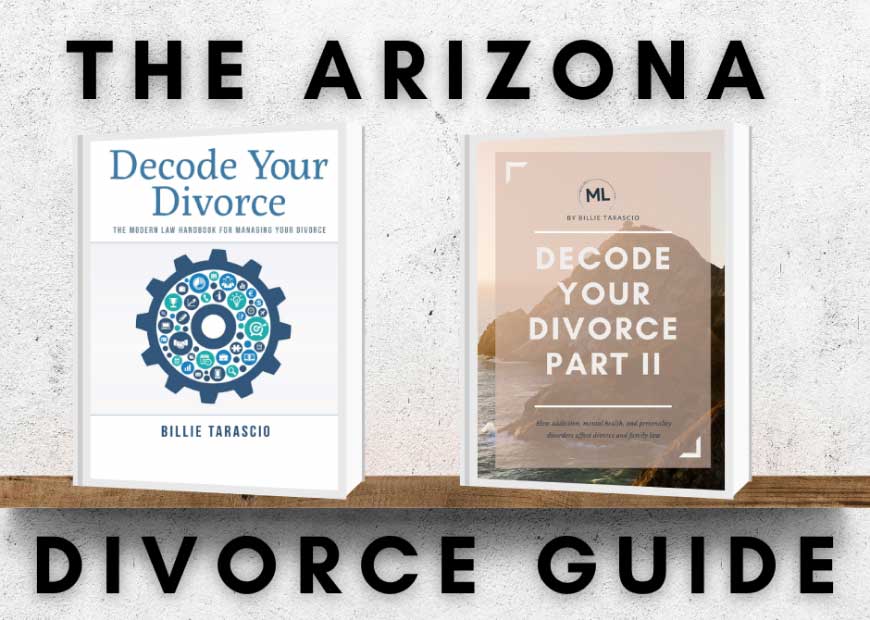Webinar Transcript Below
This is Billie Tarascio with Access Legal (now iDoOver.life) & Modern Law. I am so excited to be here with you today for an upcoming webinar and, before we begin, I just wanna tell you a bit about me and what I do and what Modern Law does and what Access Legal does.
I am a family law attorney here in Arizona.
I’ve been practicing family law for the last 10 years. I absolutely love it and I am the owner of the family law firm Modern Law. Within my work that I do at Modern Law it’s become very clear that the vast majority of people are representing themselves and there are not enough resources out there for people who are representing themselves. In fact, it’s between 80 and 90% of you who are representing yourselves in family court.
Access Legal (now iDoOver.life) is a company that was created out of Modern Law to bring law firm resources available to you, the public, who are representing yourself. And one of the things that we are going to do is be offering these webinars. Today’s webinar for instance is on how to represent yourself in family court. And, I will warn you, it is an action-packed hour of a tone of information; it is definitely a high-level view of everything that you can expect to have happened in your family law case. As we move forward in the future we will have other webinars that are more specific, will drill down into the specifics of the different areas and really answer your questions. Feel free to ask questions as we go and, if you have other webinars that you want to hear or questions that were not answered, feel free to reach out to me, either through Modern Law or through Access Legal.
STEP 1: FIGURE OUT YOUR GOALS AND OBJECTIVES
Today we’re going to be mostly focused on the process, which is long and not really easy. But we’ll also talk about the substantive law with regards to custody and divorce, because it does look like that—based on the poll—that’s something that affects everyone. Let’s start at the beginning. The beginning is before you file or before you’re served. If you know that you are going to be facing a family law issue—because you’re either facing a divorce or you’ve had a child out of wedlock—before you go to the court house, there’s some things that you should do. We should determine what your objectives are; what is most important to you. This means really thinking about what your life is going to look like in 3 years. How do you see a custody arrangement working out? How do you see a parenting plan working for you and your children? And—everyone can still hear me, right? There are some people who are saying they can’t. Oh yeah, people are saying they can. Ok, fabulous! So, we’re going to look at what are the main issues. Do you want to stay in your own house? Do you want to continue being a mostly stay-at-home parent? Are you looking for financial security? What are your most important objectives and your biggest fears?
STEP 2: FIGURE OUT YOUR RESOURCES AND BUDGET
The next thing that I’m gonna ask you to do—after you really think about what your life looks like here in the next 3 years, 2 years, one year—is to gather your resources. The process of going through a family law case is long and hard. It’s a marathon, it’s not a sprint. I’m gonna ask you to really gather your resources—both emotional and financial—so that you can make the best determinations about how to achieve your objectives and set the correct expectation.
How do you anticipate the opposing party will respond?
Is it possible for the two of you to work together to come up with some solutions that work for you? Because the bottom line is, as a family, if you’re not in a family court system, you decide how your family is going to operate.
There is no statute, there is no government, there is no one involved telling you how you are going to run your family.
You can continue to have that only if you and the opposing party can agree on how your family will continue to operate after your break-up or your divorce. If that’s not the case—if you’re not able to come to an agreement—then the statutes and rules apply and they will determine how your family is going to run. It’s usually not the best position for people to be in, so if there is any way for you and your opposing party to work it out, usually that’s a better outcome for you and your children; not always, not always. By considering these issues in advance you can better come up with and execute a strategy.
You don’t wanna go into a family court case without a strategy; without knowing what it is that you’re hoping to achieve. Otherwise you can’t really measure success and we have so many different tools available to us, both as self-representing litigants and as attorneys, to figure out how we’re going to move forward that in advance; before we file anything, we want to come up with and execute a strategy.
One of the first decisions you need to make is whether or not hire an attorney. You may or may not know this, but between 80 and 90% of people in family court represent themselves. You are the majority. You are the vast majority; in fact it’s not even close. So with that being said, there are too few resources that are really geared towards meeting your needs, empowering you and making sure that these life-changing events are handled in the best possible way.
Most people are happier if they hire an attorney, but the fact of the matter is that that’s not true for everyone and there are various reasons why people choose not to hire an attorney.
Money is the primary reason, but also people may think that they can handle it on their own or may think that it’s not a good use of their funds and I think it’s really important for you to do that analysis to determine if you have the funds, is it a good use of your funds and is it a good use of your funds to hire that attorney right now or is it a better use of your funds to map out a strategy and figure out when and if you need that attorney most and wait to hire the attorney until you need them? Usually and sometimes that’s a better idea for people and that’s what limited-scope services are.
Under a full-scope model you go in, you retain the attorney; the attorney is your attorney of record, they take care of everything for you. The nice thing with that is that you get the peace of mind of knowing that an attorney’s gonna handle everything for you.
The downside is that the average divorce in this country costs each side $20,000 and if you’re faced with the decision of ‘’Do I spend my child’s college fund on an attorney or am I a smart capable person who can do a lot of this on my own?’’—then maybe that’s the best bet for you. This is an analysis that you need to make, but I really strongly suggest that you really consider what the plan is. Don’t go into this blindly; don’t stumble along your path; really figure out what you are going to do.
There are other resources available to you besides attorneys that you can use either full-scope or limited-scope. You can use legal doc preparers. IDoOver.life is a company that is a legal doc prep company and there are many other legal doc preparers out there.
People who are legal document preparers have special certification from the Supreme Court. They are not attorneys; they have not gone to Law School, but they do know how to answer questions and help navigate you through the system, which is essential, which can be so helpful when you’re dealing with this very long and complicated process.
You also have lay legal advocates at various non-profits, your friends, a forum. We’ve created a forum on Facebook that’s for people who are representing themselves or people who are going through a family court matter. It doesn’t even have to be about representing yourself. It can be just about gathering with other individuals who are going through you’re going through, who can help give you support and say ‘’Hey, I went in front of the judge with this set of facts, and this judge, this day and here is what happened.’’ Having this sort of information really makes it so much easier for you to navigate this process.
STEP 3: THE INITIAL LEGAL FILINGS
With that being said, now we’re going to walk through what to expect when you get into the actual case and we will use legal decision-making and child custody as our example, as we walk through the process of what to expect when you’re in a family court case. The first step is your initial filings and your initial filings include the petition, the response and potentially a motion for temporary orders. When you file a petition or if you have been served with a petition, you’re going to make a statement on how you want everything; what you would like to see happen. You’re going to let the judge know what the potential issues are and how you would like the judge to resolve those issues.
With custody legal decision-making issues it’s a little bit different from when you’re going through a whole divorce, but not really all that different. I would recommend when you’re filing these initial documents—the petition, the response—that you leave yourself room for changing your position. Consider keeping these documents a bit vague, asking for something like an equitable distribution of community property or saying things like ‘’there may be separate property’’ or if you commit in your petition that a certain piece of property is separate property and then you later find out through discovery it’s not separate property, you have kind of boxed yourself in. Unless you think that you are going to go through a default—and we’ll talk about default—consider keeping the statements that you make in the petition and in the response open so that, as you get more information, you can change and refine and really hone down and specify your position.
In the 9 to12- month process that you go through, typically, to get a divorce or go through a case, you may change your mind on whether or not you want to live in the house or sell the house. You don’t wanna lock yourself down to a position now because the risk is that an attorney could come in and say ‘’Your Honour, I would like attorney’s fees be awarded to me from the opposing party because they have been all over the place on their positions. They said this in the petition, this in their motion for temporary orders; they said something else in their resolution statements; now in their pre-trial statements they are asking for something they’ve never asked before and therefore we should award attorney’s fees’’—and I have seen this happen. In order to avoid that, consider keeping your options open early on.
If you are the respondent you’ve been served with a petition, what that means is that if you’re in the state, you have 26 days to responds; if you’re out of the state, you have 30 days to respond and there’s a couple of ways that you can draft your response. Many attorneys, many people, draft a response by admitting or denying the petition in each paragraph. So the response would be ‘’so and so asks for sole legal decision-making in their position’’ and you’re going to say ‘’I disagree with petitioner’s position.’’ I would recommend that you consider drafting your response more like a counter-petition where you affirmatively state what it is that you want.
The reason is this: you don’t want your response to only makes sense in light of the petition; you want someone to be able to pick up your response, read your response and understand your position. Instead of saying ‘’I disagree with petitioner on the issue of legal decision-making’’ for instance, you instead could say something like ‘’Petitioner and I should share joint legal decision-making; we have always been parents to these children; we have always worked together.’’—that sort of thing; you can add some facts if you want to or simply just state your position ‘’we should have joint legal decision-making.’’ Affirmatively state what you want. Don’t set yourself up so that your response is basically irrelevant without reading the petition as well.
A motion for temporary orders is the other document that I include in basically set one—the initial court filings—and the motion for temporary orders can be filed by either the petitioner or the respondent along with your initial documents.
The motion for temporary orders will let you get in front of the judge—usually between 30 and 60 days after you filed a motion—to deal with imminent issues. With that being said, I should take a step back. Remember how we started with the importance of figuring out your objectives and really taking your time before you filed your documents, before you embarked on this decision. T
hat does not apply if you are in a dangerous situation or if your children are in a dangerous situation. If you and your children are not safe, then you don’t have time to come up with a strategy right now today. You don’t have time to wait and think about how really you want your life to look in three years. Let’s get you safe first and foremost, then we will work on our plan and that also ties into what we are talking about here at the motion for temporary orders.
An emergency order is separate from a motion for temporary orders. An emergency order can be filed—let’s say for sole legal decision-making if your child is in a dangerous situation— without an order in place.
So that will not take you 30 to 60 days to get in front of the judge; that will be an immediate order. You go before the judge—it’s called ex parte—it means that it’s you, without the opposing party, and you are asking the judge for an emergency order, because if that emergency order is not going granted, there will be irreparable harm. It’s something to consider; it’s something that it’s available to you. But the motion for temporary orders is not for those situations; it’s not for an emergency situation. It’s for situations where you need to figure out, during the pendency of your hearing, what the parenting plans are going to be; or you need temporary child support and you can’t wait 12 months until the judge takes the final decision on child support; or you need temporary spousal maintenance; or you need to know who’s gonna pay the bills; or maybe you wanna put the house on the market. T
here are really an unlimited amount of things that you can ask for in your motion for temporary orders, so consider whether or not that is something that you need.You can find all of these documents for free at the Maricopa County Self-Help Center. You can get them on the iDoOver.life website and they are not the same as what you would get in the county; it’s a questionnaire were you would fill out your questionnaire as you go and then you have a legal doc preparer you can consult with and talk with or you can talk to a legal doc preparer who can help you do the paperwork or an attorney. All of these are options.
There are filing fees that are required for both petitioners and respondents. If you are unable to pay that filing fee, you can ask the court to defer that filing fee. That’s something to keep in mind. You shouldn’t let the inability to pay the filing fee stop you from filing, but you should consider what it is that you’re asking for and what it is that you are writing down and drafting to the court before you file.
I’ve seen the court really come down on women who filed a petition asking for her $2000 a month spousal maintenance for the rest of their life. Some judges are offended by that, so if you leave yourself open to ‘’I need spousal maintenance to meet my reasonable needs’’ and you don’t define it and you don’t ask for how long, you give yourself time to really figure out if what you’re asking for is reasonable, who your judges, all these things that are gonna help you as you move forward.
STEP 4: DEFAULT
We talked a little in the beginning about a default. In the event that you think your opposing party is not going to respond—either because they are out of the state or they are, you know, MIA or they agree with everything—you can consider filing for a default. If you do that; if you know that you wanna file for a default—and this can be a strategic move that you and your spouse or your ex make—then what you needed to do is draft a very specific petition that also includes your parenting plan that says: here’s exactly what I want; you serve the other party; you pay your filing fee.
If the other party agrees, then you can go forward with the default and that opposing party avoids paying a 268-dollar response fee monthly, so it’s an absolutely valid strategy to people who agree, because there’s no way in Arizona for you to get an uncontested divorce. Someone must file a petition; same thing with establishing paternity legal decision-making, which is legal custody. And let’s just talk for a minute. We’ll pause on default and talk for a minute about these terms.
Legal decision-making is legal custody. It’s who makes the major decisions for the child—where they go to school; whether or not they get on medication; or get a surgery that might not be an emergency surgery, that sort of thing; their religion and personal care decisions. Most of the time, the courts prefer joint legal decision-making, which requires both parents to talk and make decisions together.
That’s not always the case and there could be very good reasons why there should not be an award of joint legal decision-making. So do not think that you have toask for joint legal decision-making. I’m seeing right now a lot of pressure being put on people. They’re being told ‘’Don’t even bother asking for sole legal decision-making.’’ And that’s a mistake.
You really need to look at your facts and apply the law and then determine what’s gonna be most appropriate for you. Legal decision-making is separate from parenting time and Arizona has done away with the term visitation. No one, no parent is given visitation. Each parent is given parenting time. And we have statutes in place that require very specific rules for the parenting plan that must be in place. It’s not ok for the two of you to come up with a parenting plan that is, you know, so and so will be granted liberal or reasonable parenting time. The courts and the statutes require that you have a specific parenting plan in place that deals with vacations, holidays, transportation and specific days and times for each parent to have parenting time.
With that being said, there is also a preference for maximizing parenting time with both parents, when you have good parents, when you have safe parents. If that’s not the case, then you do not need to feel pressured into entering into an equal parenting time arrangement; if that’s not what best for your children; that’s not right in your circumstances. We really do have to look at that case-by-case basis.
With that little aside, we’ll go back to the default. If you have served the opposing party and they have not responded—they have 20 days to respond in Arizona; 30 days to respond if they are out of Arizona—then you can file an application and affidavit for default.
They get 10 more days to respond and you serve them with that application and affidavit of default. At that point you can request either a hearing—if you have children—and you would go before the judge for a default hearing or you can submit paperwork—a decree for the judge to sign—if there are no children involved.
Be aware, one more piece of time frame to keep in mind is that there’s a 60-day waiting period for divorce, so you can’t file really your application and notice of default or submit your decree to get it signed before that 60 days. That’s something to keep in mind when we are also considering the 20 days plus the 10 days; we’ve got a factor in those 60 days as well.
A hearing is usually required when there are children involved. So what that looks like is you call the court; you make an appointment; you and a bunch of other people show up on the day of your default hearing; you wait in line; you go before the judge. The judge will compare the petition and the decree, so you have to bring a decree with what you want to have happen.
The decree must match what you’ve ask for in the petition, because the person who was served—the respondent who did not respond—deserves to know what it is that they have waived their rights to by failing to respond. We cannot have a very vague petition that you then go get a default judgement on. That’s something to consider. What we might have to do in that case is amend your petition, make it more specific, then ask for a default. After these initial filings, you might do the default, you might not. Don’t go through default and your opposing party goes ahead and responds; then the next phase of your divorce—really phase two or phase three if we might consider a default phase two and then the discovery and [inaudible 23:07] disclosure phase three. This is where we get into disclosure and discovery.
STEP 5: DISCLOSURES AND DISCOVERY
In family court disclosure and discovery is really not optional; it is mandatory. That means if you’re going to use an exhibit, if you’re gonna use a witness, it must be disclosed and Rule 49 sets out the mandatory minimum disclosures. The rule is lengthy; it’s complicated.
We created a fantastic chart for you that you can check out. It’s hosted on the iDoOver website. It shows you exactly if parenting time is an issue, here’s what must be disclosed; if there is a protective order in place for anyone that lives in either household, here is what must be disclosed; if there’s criminal records, here’s what must be disclosed; if it is property, here’s what must be disclosed. It’s an excellent chart for you to review. This lets you now, not only what your obligations are in disclosure, but what you can expect to get from the opposing party. So check that out and let me know if you have questions on it.
This brings us to the next topic on disclosures and discovery and the rules of evidence. In family court, the rules of evidence are relaxed. That means the same rules that you have in civil court—objections to hearsay or authenticity of documents—don’t apply in family court. In family court the general rule is that any evidence that’s relevant will be admitted. That is unless a notice of strict compliance is filed. A notice of strict compliance is not a request to the court; it’s putting the court on notice that the rules of evidence—the civil rules of evidence—will be in effect. I would advise you to think long and hard before filing the notice of strict compliance.
It makes it more difficult for you to prove your case. What that means is that instead of submitting a police report as evidence, you need to actually subpoena the police officer who has to come and actually testify because that’s the best evidence; the best evidence of what happened is not the report, but the actual witness who saw the event, so that’s just something to keep in mind. If the opposing party or the opposing party’s representative and their attorney files a notice of strict compliance, we’ll need to do a crash course for you on the rules of evidence and that might be a different webinar that we put onor a series of blogs. If that’s something that you need to know, just let me know; put it in your questions and then we’ll know what we need to cover.
I love that these questions are coming in; they’re fantastic, but I’m going to keep going on the actual presentation and then try to get to as many of these as we can when we’re done. Please keep them coming and I promise we will go through all of these at the end, okay? Discovery tools: if there is—you looked at Rule 49; you need XYZ; let’s say you need access to their bank records and they’re not handing them over or you know they’re hiding assets or you think there might be something really terrible—like child pornography or something like that—there are discovery tools that you can use in addition to the Rule 49 disclosures. The discovery tools are interrogatories which are questions that are asked and served upon the opposing party. They must answer them within 40 days. There is a set of uniform family law interrogatories that are fantastic. I mean, they are fantastic! They ask for things like, you know, name every account you have, name all the people who live in your house and any criminal record they have. It’s extensive; it’s great! You can currently get it on the iDoOver.life website.
You can also serve non-uniform interrogatories. Non-uniform interrogatories are questions that you make up. For instance we thought the opposing party in one of my cases was hiding rental income, so we created a non-uniform interrogatory that said ‘’identify each and every house you own, who lives in the house, how much the mortgage is and what is paid in rent.’’ That’s not a uniform interrogatory, it’s a non-uniform interrogatory and you’re limited in the number of those that you can use, but they’re very powerful discovery tools.
The next discovery tool you have available to you is the request for the production of documents or things or items. You can request someone’s computer. You can request that that computer be imaged by a forensic analyst who then goes through and searches for things, you know, in the child pornography example that’s a reason we would want to get their actual computer or image their computer or their tablet. We can also do that with someone’s phones. We can look for bank accounts. You can request specific items, lots of specific items, using this request for production of documents. And again what we’d wanna do is think back for a strategy, think back to what we must prove and then request what we need to using these discovery tools.
A request for admissions is a separate document that goes out and says ‘’Did you do XYZ?’’ They have to lock down yes or no. And why do you do these interrogatory and these requests for admissions? Because you lock down their answers and you can use this as evidence and you can use it to impeach them. And impeachment means you’re proving them a liar; that’s what it means. We wanna start with these tools and using these tools and gathering our evidence soon. There is a reason that I put this in the process right after the filing of the original and initial documents. You do not want to wait. The reason is that the same information is used not only for trial prep, but for negotiation and for settlement. It’s information that you’re entitled to. A subpoena is a little different because it’s like a request for production of documents or a request for a witness that goes directly to the third-party: a bank, a witness, a school, any third party who has information that you need. Bear with me for one second while I take some allergy medicine. Thanks! I don’t know about you, but the orange blossoms have been killing me.
STEP 6: PREHEARING CONFERENCES
In the family court there are a series of prehearing conferences that are designed to help facilitate settlement, narrow the issues and figure out what the case strategy is going to look like. A resolution management conference is an RMC. It’s typically scheduled when there’s attorney, sometimes if there’s no attorney. A resolution management conference is about half an hour. You have to file a resolution statement prior to this. You can get that form on from us at IDoOver.life or on the Maricopa County Superior Court website. You wanna be pretty specific in your resolution statement about exactly how you’d like the case to be resolved. You can’t do a good RMC statement without the information that you gathered during discovery. How do you know how you wanna specifically split the assets if you don’t know exactly where they are or exactly who owns them or exactly what the terms of the interest rate are? That’s why discovery’s so important. The resolution management conference is a half an hour. It is in front of the judge that is assigned to your case at the court house.
One quick thought on this: you have the ability to change your judge once as a matter of right before you go in front of the judge. If you are assigned a judge that you do not want for your case, you need to file a notice of exchange of judge before the RMC. At the RMC you tell the judge how you want things to move forward. Not only do you tell them how you want the substantive issues to be resolved—for instance, I want Joey to go to X school or whatever kiddo issues you have going on or money issues—but also do you want certain experts appointed; do you wanna go to a parenting conference; do you want to go to an ADR; do you want a comprehensive family analysis; do you want a drug testing for the other party? What sort of things do you need the judge to order, this is the time to ask.
An early resolution conference is different. It is set with conciliation services.You go in front of the third-party mediator. It’s you and the other party; usually this is set when there’s no attorneys, but sometimes attorneys get to go. One time I got to go and I was able to really help my client facilitate a fantastic settlement. It’s set for 3 hours. It’s different from an RMC. You’re not in front of the judge and you don’t have to file a RMC statement in advance, but you’re gonna want to bring your evidence, because that’s gonna help you negotiate.
An ADR stands for alternative dispute resolution. This is usually a judicial settlement conference. This is a three-hour conference that is assigned to, not your judge, but a judge pro tem. They are usually an attorney or someone who has a lot of experience in family law. Their job is to help facilitate the settlement. Before you go to the ADR, you submit a confidential memorandum to that judge pro tem, outlining all of your positions. This is like your pre-trial statement.You are going to want to have all of the information that you need going into it, so again this is why discovery is so important. The other prehearing conference that you might get is a return hearing or as a status conference. That is a little more loosely defined; sometimes they take evidence, sometimes they don’t. It’s just an opportunity for you to talk to your judge—sometimes it’s telephonic, sometimes it’s in person—kind of come up with an idea of what’s gonna happen. Maybe you’re gonna set a case for trial, maybe you’re gonna go over the remaining outstanding issues etc. etc.
Prehearing conferences are designed for a lot of different purposes and we just talked about those, but the other thing to consider here throughout all of this is negotiations. You should make a good-faith effort to look like you are negotiating. It’s important. If you don’t, you are exposed to paying the other party’s attorney’s fees. Unless you’re in a position where you are afraid of the opposing party, you should try to engage in negotiations as much as possible. With that being said, there is many ways with to do it. If you are afraid of the opposing party, you can engage in negotiations in writing or via attorneys. You don’t have to do it yourself; it doesn’t have to be in person. And when we do mediations or ADR, alternative dispute resolutions or judicial settlement conferences, we can absolutely have the parties be in different rooms where they never see each other. Another option is that someone—one party—shows up an hour earlier than the other party so that you’re never ever seeing each other. It is absolutely an option.
STEP 7: TRIAL PREPARATION
Let’s talk about trial prep. Now, all of this is kind of trial prep, but it’s also negotiation prep and case prep and helping you to figure out what it is that you want. When you are engaged in trial prep, here’s what you’re looking at: you need to identify all of the remaining issues that have not been settled—property divisions, spousal maintenance, parenting time, child support. Once you’ve identified the issues, then you need to look at the law to figure out the elements of each issue—for instance child support. Child support is calculated pursuant to a calculator. The elements of child support are mum’s income, dad’s income, childcare expenses, healthcare expenses, any extraordinary expenses. You need to drill down into the elements and make sure that you have the information that you need to prove each of those elements. How do you prove mom’s income, dad’s income, healthcare expenses? This is all information you’re going to need in order to prepare for trial and prove your case.You’ll need to look at the statutes, which you can find under Title 25 of the Arizona Revised Statutes. That’s all of the family law statutes. If you look at each one, you know, the one on parenting time will give you all the factors that the judge will consider when determining what the appropriate parenting time arrangement is. At this point you are gathering legal information and analysing that legal information and applying your facts to that legal information. Get help; consult the statutes, lay legal advocates, people who have been doing this before, doc preparers, attorneys; do what you need to do to make sure this is your very well-prepared and you can articulate the facts and have the evidence that the judge actually cares about.
Pre-trial statement—there was a question about a pre-trial statement. The pre-trial statement is the most important document in your entire case. I cannot emphasise enough how important this document is. This document identifies all of your issues, gives the procedural history and background of the case, cites the law, applies your facts to the law and incorporates exhibits.
Last week I had a hearing with a client. The other side was represented as well. We had submitted to the judge a joint pre-trial statement laying out here’s what’s happened in the case, here are the outstanding issues, here is the law, here is how we applied —each of us each—each attorney applied our facts to the law and we gave it to the judge in advance. When we walked in for trial that day, the judge had written up for us his presumptive findings. He had already drafted his ruling.
He called us back in chambers. He said ‘’Look, I’m open to changing my mind once I hear a testimony, but here’s what I’m thinking I’m gonna do.’’ It was incredible! This tells you how important this document is. If you pay an attorney for one piece of your case, I recommend you pay them to do a prehearing statement for you; take your exhibits; apply your exhibits. The reason is you’re going to use this as an outline for everything. We can talk more about that if you’d like.
One question that I had earlier was ‘’Is there an example?’’ Not really. It’s one of the things that Access Legal is working on creating—a document library with actual examples, showing you how different people have constructed their arguments. It doesn’t exist right now for [inaudible 44:10] litigants and I’m sorry; I think it’s a tragedy.
But, at this point, I don’t have a great way to show you, you know, 10 examples of different awesome pre-trial statements, but we’re working on it. Alright, what are you going to use for witnesses and exhibits? How do you determine what you’re going to use or who you’re going to use?
You look at your pre-trial statement. Your pre-trial statement shows you what fact you must prove. If you must prove dad’s income, you know that you need an exhibit that shows dad’s income. If you have to prove that dad never showed up to pick up little Johnny on time, then you’re going to need exhibits that show that dad never picked up little Johnny on time or witnesses from the childcare center that can say that dad never picked up little Johnny on time. If there are facts really important to you that cannot be applied to an element, you don’t get to use them. So if there is something that is very important to you, for instance your ex cheated on you and you’re pissed and you want the judge to know; I don’t blame you, you know, it makes sense that you are upset and you want the judge to know, but we have a no-fault divorce state, so it’s really not relevant, unless we can show waste—community waste of assets. If you put in legal argument an analysis related to waste, then you get to bring up the fact that your spouse cheated on you and spent all this money. You must figure out a way to get the facts that are important to you to apply to an element of a legal issue.
STEP 8: TRIAL PRESENTATION
Let’s talk now a little bit about trial procedure. We have 10 minutes left, so I’m going to attempt to get through the rest of this very quickly and then answer your questions in the last 5 minutes. Trial presentation works like this: first the petitioner goes, the petitioner will call his or her first witness—usually that’s you—you will testify as to what’s important. How do you know what to testify to? You testify based on what’s in the pre-trial statement, because if you’ve done a great pre-trial statement, your pre-trial statement is exactly what the judge needs to know. That is your testimony. That is the question you’re asking dad. That is your outlined new use and trial, because that is what the judge has used as evidence by the fact that the judge brought up a draft agreement based on our pre-trial statement. Alright, so the petitioner goes first; you’re going to offer your testimony. The opposing party has the ability to ask you cross-examination questions. Answer these questions as quickly and succinctly and without animosity as much as you possibly can and that’s where we get into the decorum piece here. You want to kind of be on your best behaviour. Judges want to feel like you respect them and respect their court room. It’s a place that is more traditional than many of the places that we attend in society and so some people are really shocked by the level of respect that is expected by the judge and the level of decorum, but it is there, it is real; you have to follow it, it will help you.
The opposing party is going to ask you cross-examination questions. You have the ability to redirect or re-clarify anything based on what they asked you. And you get to do that for every single witness. After you’re done with you, you call your next witness; you ask them questions; the opposing party asks questions, then you get to ask clarifying questions.You do that until you’re done presenting your case. You use the exhibits to bolster the testimony. The exhibits really don’t and cannot speak for themselves, so each—I’m sorry, the evidence—each exhibit must be authenticated, which means you must say ‘’I’m looking at father’s pay steps from this month to this month, which says bla bla bla bla bla.’’ You have to tell the judge what the exhibit says; then you can show the judge the exhibit. Then you need to offer the exhibit—and you do that by saying ‘’I offer to admit exhibit X’’—so you’re going to submit to the court, let’s say, 30 exhibits prior to trial. You’re gonna give that to the court, to the opposing party. Some judges want a copy, some don’t. You can call the court and find out exactly what judges want a copy of the exhibits and which don’t.
In order to have the exhibits actually looked at by the judge, you’re going to have to offer to admit the exhibit. At that point the other party has the ability to object by saying ‘’I object.’’ What are the bases for objection? Irrelevance; wasn’t disclosed; not previously disclosed—those are all reasons to object. If the exhibit doesn’t say what they’re purporting, it says—so for instance, in a case I was working on last week, the other side was trying to put in exhibits that had nothing to do with the case; that had to do with, you know, his wife’s grandparents’ money that they earned and it didn’t have anything to do with the case and they were trying to argue that it had to do with showing that he worked for them, but it didn’t show that he worked for them, so we objected.
The objection was sustained, which means yes, I agree with you councillor, it doesn’t get it. If the exhibit is not admitted, the judge doesn’t look at it and the judge most likely has not looked at your exhibits before you’ve got into trial. Okay? So you’re going through your case, you’re presenting your witnesses, you’re presenting your evidence, you’re offering to admit your exhibits, then you’re going to rest your case. The opposing party does the same.
Most often there is no closing argument or opening argument, although you might be able to submit a closing argument in writing—a closing brief to the court—and that’s something you are probably entitled todo. You can ask the court or you can simply do it. What to expect? You finished, they finished. It’s now time for everybody to go home. You want the court to give you a ruling. They’re probably not gonna give you a ruling. Most likely the judge is gonna take the matter under advisement and you’re going to receive a written ruling sometime between 30 and 60 days later. During that period of time, the status quo remains. If there is temporary orders in place, they control. You’ll just continue doing what you’re doing.
Now, just finally you get the ruling and there’s something horribly, terribly wrong. What are your options? Motion to clarify, motion to reconsider, an appeal or Rule 85 motion to set aside. There are good reasons to do this. For instance in a divorce that I was working on about two years ago, we got the decree and the decrease did not divide all of the marital property, so it wasn’t clear who owned the business or the houses or, you know, the boat and the cars and they hadn’t been divided, so that was a really good reason for us to file post-decree motions regarding the actual decree—it does happen and there are other reasons you wanna do that.
Call 480-649-2905. Schedule a confidential consultation today to discuss a legal solution and options that best fit your budget and situation.









